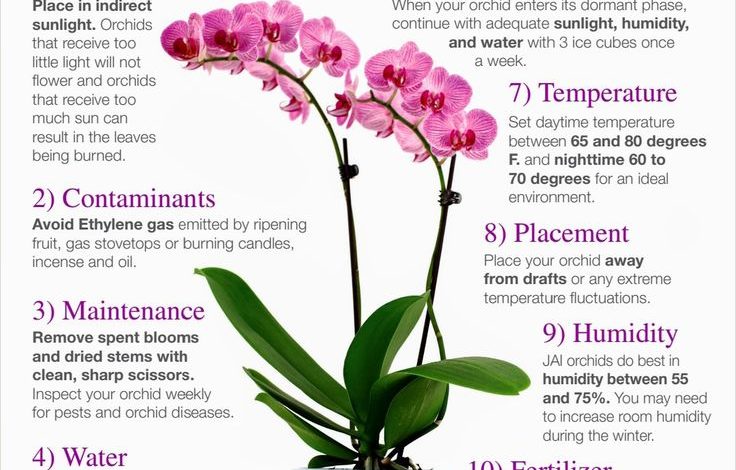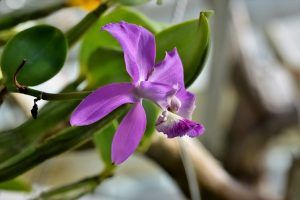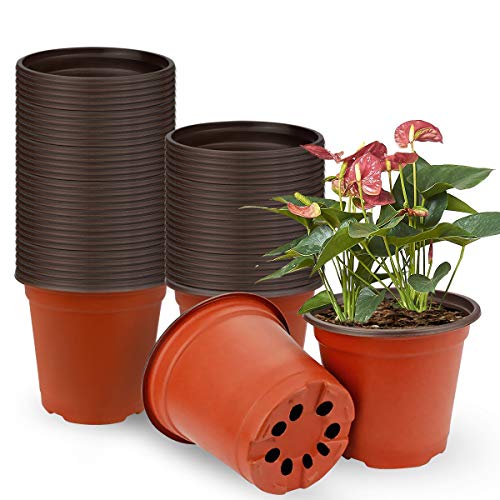Plant Orchids in Your Garden: [8 Steps + Images]

Orchids have fascinated the world for centuries because of their beauty and the many characteristics that make themuniquein the plant kingdom.
It can be considered an ornamental plant, due to its enormous beauty.
They are present almost everywhere in the world, although they develop preferentially in the tropics.
Important Points for Planting Orchids:
 Choose well the variety of orchid you want to plant. Keep in mind that there are many varieties and they all require different conditions.
Choose well the variety of orchid you want to plant. Keep in mind that there are many varieties and they all require different conditions.- We recommend that you plant the orchids in a pot, since they are flowers that grow on stones and trees. They do not tolerate growing well on land and end up dying.
- The substrate that we recommend to fill the pot: dry leaves, coconut tow, charcoal, moss, crushed tree bark, etc.
- They require humidity, but without waterlogging. Ideally, drip irrigation.
- Orchids require a high content of potassium and calcium, since these are nutrients that they cannot take from the substrate where they are grown and require that we provide them.
- We can plant orchids throughout the year.
- Do not plant them in a place with direct sun exposure. They burn easily.
- They can take up to 2-3 years to flower.
Orchids belong to a very large family, in fact it is the one with the most species in the entire plant kingdom and they are capable of growing indoors and outdoors.
However, some orchids are easier to grow than others and, in many cases, their planting and maintenance can be complicated.
This is why its commercialization has become so expensive, since forplant orchids successfullyit is required to meet certain requirements.
This does not mean that you cannot do it yourself. On the contrary, here we tell you the most effective way to grow your own orchids.
What do we need to plant orchids?
Orchid Varieties
There are so many varieties of orchids, each with different cultivation characteristics, that it would be impossible to describe the cultivation process of each one.
- Genus Cymbidium.
- Genus Cattleya.
- Genus Phalaenopsis.
Each one requires different ideal conditions of humidity, temperature, irrigation and light.
If you want to plant orchids of a different species, we recommendinform you in detail about all the featuresnecessary to grow your orchid in the most efficient way.
To know more, read: Varieties of orchids.
In a pot, pot or container?
Another consideration that you must take into account before planting orchids is thatIt is more practical and easy to do it in pots.
You must remember that almost all orchids are epiphytes, that is, they live on trees and rocks, and their roots do not like to be buried.
 Therefore, if you try to plant it in the ground, in your garden or orchard, it is most likely that the roots will decompose and your orchid will die.
Therefore, if you try to plant it in the ground, in your garden or orchard, it is most likely that the roots will decompose and your orchid will die.
In specialized stores you can find special pots to grow orchids.
They are ordinary pots, except that they have holes on all sides to allow the roots to breathe.
To choose the most suitable pot, you must take into account the variety you want to grow.
Most orchids do well in small and medium containers. Others, like Cymbidium, require larger pots to accommodate their extensive root system.
If you don’t want to use clay pots and don’t want to invest in a special orchid pot, you can use any of the following options:
Types of pots for orchids:
- Metal mesh pots: They facilitate the breathing of the root system and since they are light, they are easy to hang in places where they can better receive sunlight.
- Transparent plastic pots: They help the roots receive better sunlight, in addition to allowing you to monitor the root system without disturbing the orchid.
- Wooden pots: These are made of rot- resistant wood and have small interstices that allow good drainage and breathing of the roots. Put a layer of moss on it before adding the substrate mix.
The substrate: How do we prepare the land to plant orchids?
Before planting the orchids, make sure thatyour pot is well disinfected.
Later, fill it with a peat -based substrate: dry leaves, coconut tow, charcoal, moss, crushed tree bark, etc.
Remember, it is very important: Do not use earth. Orchid roots need air, so they benefit from a looser, more porous mix.
You can prepare three basic types of substrates:
fine substrate
Suitable for the vast majority of Oncidium or Damas Danzantes orchids, Paphiopedilum or Zapatito orchids, Oncidiinae or Miltonias orchids and, in general, for all those orchids with small roots that require higher humidity:
medium substrate
Suitable for Cattleya orchids, Phalaenopsis and other mature orchids:
- 4 parts medium grain fir bark or coconut shell.
- 1 part medium grain charcoal.
- 1 part perlite.
coarse substrate
Suitable for Cymbidium orchids and other large orchids:
- 4 coarse-grained parts of spruce bark or coconut shell.
- 1 part medium grain charcoal.
- 1 part perlite.
If you’re not sure which mix to use, try a medium or coarse soil mix before using a fine soil mix, or consult an expert.
Cymbidium orchid variety
 A pH of 5.0 to 6.0 is recommended.This variety adapts relatively well to a good number of substrates.
A pH of 5.0 to 6.0 is recommended.This variety adapts relatively well to a good number of substrates.
One of the most recommended substrates is:
- 6 parts of coniferous bark.
- 2 parts cloudy blonde.
- 2 parts of granulated polystyrene 1.5 cm thick, which is placed as drainage at the bottom of the pot.
- Subscriber: every twelve days.
Cattleya orchid variety
A pH of 5.0 to 6.0 is recommended.It requires a porous substrate, with easy drainage of irrigation water and good air circulation.
One of the most recommended substrates is:
- 7 parts of coniferous bark.
- 2 parts cloudy.
- 1 part polystyrene or perlite.
- Subscriber: every 15 days.
Phalaenopsis orchid variety
The substrate based on peat and pine bark is the most appropriate.
The size of the pot is very important. A small pot is preferable, as the plant is compacted inside the container and grows much better than in a larger pot.
Subscriber: once a month.
The nutrients that orchids need
 It is recommended to fertilize them once a month at most. If you over-fertilize them, you will increase the chances that the roots will burn and flowering will be prevented.
It is recommended to fertilize them once a month at most. If you over-fertilize them, you will increase the chances that the roots will burn and flowering will be prevented.
During the autumn and winter periods, you can fertilize them every 15 days, depending on the conditions in your region.
Use orchid fertilizer, or if you prefer you can make your own mixture.
Orchids require a high content of potassium and calcium, since these are nutrients that they cannot take from the substrate where they are grown and require that we provide them.
Make your own fertilizers with:
- Crushed eggshell (Make sure you wash them well and let them dry before crushing them). The finer the grind, the better. Just sprinkle it on the roots.
- Potato or rice cooking water: The water in which we have cooked the potatoes is rich in potassium and calcium. Rice cooking water is rich in vitamin B. You can store them in the fridge and use them every two weeks to water the orchids.
- Milk: It is another source of calcium. Dilute 1 part milk to 4 parts water and use this mixture to water your orchids every two weeks.
- Used tea bags: Let them dry and spread the contents on the base of the orchid about once a month. You can also use oak leaf tea.
Mix 1 part water to 2 parts oak leaves and leave in the sun for two weeks. After this time, use the liquid to water your orchids.
To avoid over-fertilization, use no more than two of these remedies at a time.
When to plant orchids?
The Cymbidium, Dendrobium and Oncidium genera can be grown throughout the year, as long as they are protected from frost, rain and direct summer sun.
Others, such as Phalaenopsis, require a night temperature of 18ºC, so it is not recommended in regions where winters are very harsh.
Even in temperate regions, it is essential to provide them with abright and warm place.
Where? The temperature and the light
 As we have already seen, due to their Tropical nature, orchids are used to good air circulation and lighting.
As we have already seen, due to their Tropical nature, orchids are used to good air circulation and lighting.
Try to locate the plants in sunny places during the fall and winter, avoiding direct sun at noon.
Most orchids enjoy more indirect sunlight, as direct sunlight can burn them.
The temperature (depending on the species of orchid) ranges between 18 and 23°C during the day, with a difference of no more than 7°C compared to the night.
If orchids don’t get enough sunlight, they won’t flower.
If you want to make sure that the light conditions are adequate, check that the leaves of your orchid are dark green. If the leaves are yellowish or reddish, it means that they are receiving too much light.
- Paphiopedilum, Phalaenopsis and Oncidium orchids are less demanding in terms of light.
- Cattleya, Dendrobium and Vanda orchids require a lot of light.
You can place your orchid behind the curtain or blind. In this way, you will be able to receive a lot of light, but in an indirect way.
Cymbidium orchid variety
 In the summer period, it requires a maximum daytime temperature of 28ºC with normal lighting and a maximum night temperature of 14ºC.
In the summer period, it requires a maximum daytime temperature of 28ºC with normal lighting and a maximum night temperature of 14ºC.
During the autumn and winter periods, a temperature of between 12 and 15 ºC will be necessary for flowering.
If maximum temperatures are exceeded, the leaves will drop and flowering will be affected.
Cattleya orchid variety
It requires a maximum daytime temperature of 28ºC and a maximum night temperature of between 17 and 18ºC.
During the summer, good aeration is necessary.
It is preferable to grow it in a greenhouse, since it is about plants with short days and it is possible to advance or delay flowering.
Phalaenopsis orchid variety
Its optimum growth temperature is between 20 and 25 ºC.
How do we water them? Humidity
Important points when watering orchids:
- Watering Frequency: Usually 2 times a week in the summer and 1 time a week in the winter.
- Irrigation method: By immersion.
- Optimum time of day for irrigation: In the mornings. It is necessary to avoid the hottest hours and to spend the nights with excess humidity.
- Identify excess water: Root rot.
- Identify lack of water: the lack of water is noticeable in the roots, which tend to turn pale.
What irrigation needs do they have?
Orchids enjoy an environment with controlled humidity, so irrigation is a fundamental part of their care. However, this does not imply that they need huge amounts of water to counteract the climatic conditions of the environment.

The reality is that irrigation needs are determined by the climate in which you are living, more in summer and less in winter.
How can we detect the lack of irrigation in orchids?
 Orchids are a very large family of species and the ways of «communicating» that each one handles are variable.
Orchids are a very large family of species and the ways of «communicating» that each one handles are variable.
In some cases, the roots change color when they feel dry (they turn pale), while others reduce the number of stems in the structure.
At some point the symptoms of lack of irrigation will begin to be noticed in the leaves, which will lose vigor, as well as in the flowers.
How often should we water?
The irrigation pattern of orchids cannot be limited to a series of general conditions applicable to all species. This is because each of them has a different work system and, therefore, their irrigation patterns vary.
For most cases, you’ll want to set your waterings to twice a week on warmer days and once on cooler days.If it rains and the orchids are outdoors, you will have to suppress the irrigation that corresponds to that moment because they will already take the humidity they need.
The most advisable thing around this point is to know very well the type of orchid you have. When buying it, it is best to consult with the specialist seller about how and how often you should water it to avoid future inconveniences.
What is the best way to water them?
The safest method of applying irrigation to orchids is by means of immersion. The process consists of placing a plate under the pot where you have the orchid planted and filling it with water.

Naturally, the pot must have holes through which the roots can absorb water.An important note is that the amount of water you put in the saucer should not reach half the height of the pot.

Now, after about 15 minutes have passed, the time will come for you to remove the plate and let the water drain by placing the hung plant in one place. When it has spent an hour draining, approximately, you can relocate it in its normal space.
How do we detect excess water in orchids?
Overwatering orchids is, simply put, a deadly weapon. Orchids are accustomed, due to their natural conditions, to enjoying an environment of high humidity, as occurs in tropical forests. However, its roots are free.
This freedom supposes that they are not subjected to stagnant water, but consume what is strictly necessary for their survival. When we have them at home and force them to «enjoy» more liquid than they can handle, their roots will turn dark brown as a sign of rot.

What is worse, due to the specific conditions of this plant, it is an issue that has no turning back. Another important point in this whole topic is the water that you will use to irrigate. In general, you have to avoid hard water or water with added chlorine.
If it is rainy time, collect a little of it and take advantage of it, since it contains the ideal components for orchids. With all these details, you will have what it takes so that the irrigation of your orchids is no longer a headache and your plant is healthy.
Maybe you are also interested in:
- Poppy: [Characteristics, Cultivation, Irrigation and Care]
- Afelandra or Zebra Plant: [Care, Planting, Irrigation and Substrate]
- Agapanthus: [Cultivation, Care, Irrigation, Substrate, Pests and Diseases]
- Bear Garlic: [Cultivation, Care, Irrigation, Substrate and Characteristics]
- Aquilegia Vulgaris: [Planting, Care, Irrigation, Substrate, Problems]
- Aster: [Cultivation, Irrigation, Care, Pests and Diseases]
- Azaleas: [Planting, Care, Irrigation, Substrate and Diseases]
- Begonia Elatior: [Characteristics, Cultivation, Care, Pests and Diseases]
- Calibrachoa: [Siembra, Cuidados, Riego, Sustrato y Plagas]
- Cayena: [Cultivo, Riego, Asociaciones, Plagas y Enfermedades]
- Clavel Chino: [Cultivo, Cuidados, Plagas y Enfermedades]
- Cómo Cultivar y Cuidar Tu Orquídea Phalaenopsis: [Guía Completa]
- Cómo Sembrar Azafrán de Forma sencilla y eficaz
- Cómo Sembrar Azucenas en Tu Jardín o Huerto: [Guía Completa]
- Cómo Sembrar Capuchina en tu Jardín: [Guía Completa y Pasos a Seguir]
- Cómo Sembrar Flor de la Pasión en Tu Jardín: [Guía Completa]
- Cómo Sembrar Hibisco en tu Jardín: [Guía Completa]
- Cómo Sembrar Lirios de Agua: Puntos Importantes + Imágenes + [9 Pasos]
- Cómo Sembrar Rosas en tu Jardín: [Guía Completa + Paso a Paso]
- Cómo Sembrar Tulipanes y tener un Jardín Espectacular: [12 Pasos + Imágenes]
- Cómo, Cuándo y Dónde Sembrar Hortensias: [Guía para tu Jardín]
- Crisantemos en tu Jardín: [Siembra, Cuidados, Riego, Sustrato]
- Crocus: [Siembra, Cuidados, Riego, Sustrato y Plagas y Enfermedades]
- Cultivar Amarliys: [Cuidados, Siembra, Riego y Sustrato]
- Cultivar en tu Jardín la Tradescantia (Tronco de Brasil): [Riego, Cuidados, Poda y Sustrato]
- Cultivo de Madreselva: [Cultivo, Riego, Cuidados, Plagas y Enfermedades]
- Diente de León: [Cuidados, Siembra, Características, Riego y Sustrato]
- Flor de Jericó: [Cultivo, Cuidados, Plagas y Enfermedades]
- Flor Eléctrica: [Cultivo, Cuidados, Riego, Sustrato y Plagas]
- Flores Amarillas: [Especies, Cuidados, Características y Significado]
- Flores Azules: [10 Ejemplos, Cuidados, Características]
- Flores Blancas: [Lista Completa de 16 Plantas + Imágenes]
- Flores de Bach: [Ejemplos, Cuidados, Características y Significado]
- Flores de Otoño: [Nombres, Listado, Cuidados y Características]
- Flores de Primavera: [Listado, Cuidados y Significado]
- Flores de Verano: [Nombres, Listado, Características y Cuidados]
- Flores Híbridas: [Listado, Ejemplos, Características y Cuidados]
- Flores Llamativas: [Listado, Ejemplos, Características y Cuidados]
- Flores Moradas: [Listado, Ejemplos, Características y Cuidados]
- Flores Naranjas: [Ejemplos, Cuidados, Características y Significado]
- Flores Negras
- Flores Trepadoras: [Listado, Ejemplos, Características]
- Flores Tropicales: [Tipos, Características y Cuidados]
- Flores Violetas: [Ejemplos, Cuidados, Características y Significado]
- Forsitia: [Siembra, Cuidados, Riego, Sustrato, Plagas y Enfermedades]
- Freesia: [Siembra, Cuidados, Riego, Sustrato, Floración y Más]
- Galán de Noche: [Siembra, Cuidados, Riego, Plagas y Enfermedades]
- Guía Completa Para Sembrar Clematis en tu Jardín


![Photo of Bach Flowers: [Examples, Care, Characteristics and Meaning]](https://www.complete-gardening.com/wp-content/uploads/2022/08/bach-flowers-examples-care-characteristics-and-meaning-390x220.jpg)


![Photo of White Mold in your Garden: [Identify, Prevent and Treat]](https://www.complete-gardening.com/wp-content/uploads/2022/08/white-mold-in-your-garden-identify-prevent-and-treat-390x220.jpg)